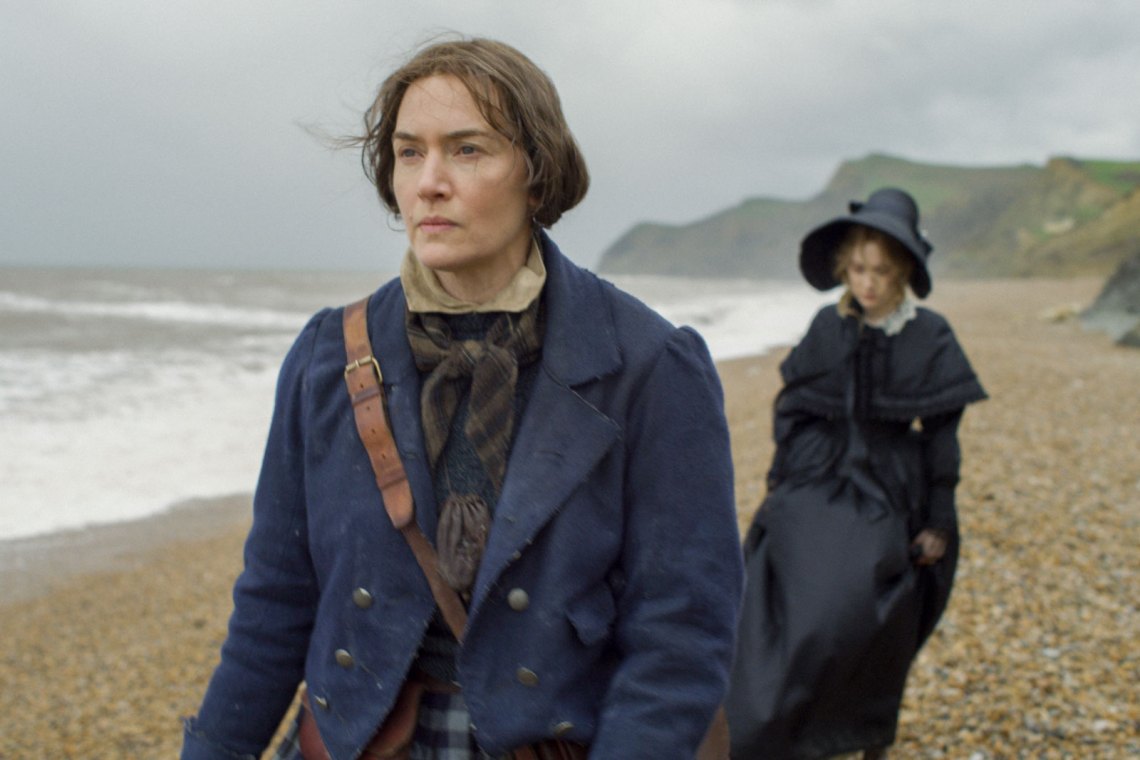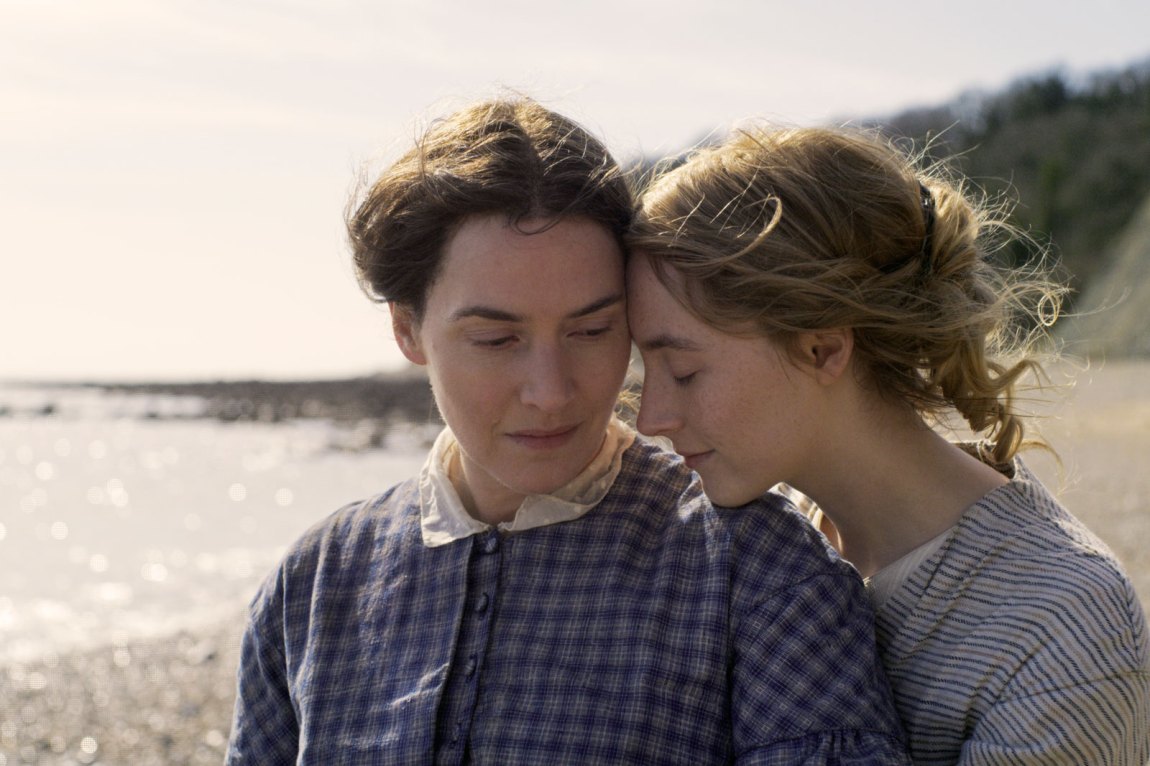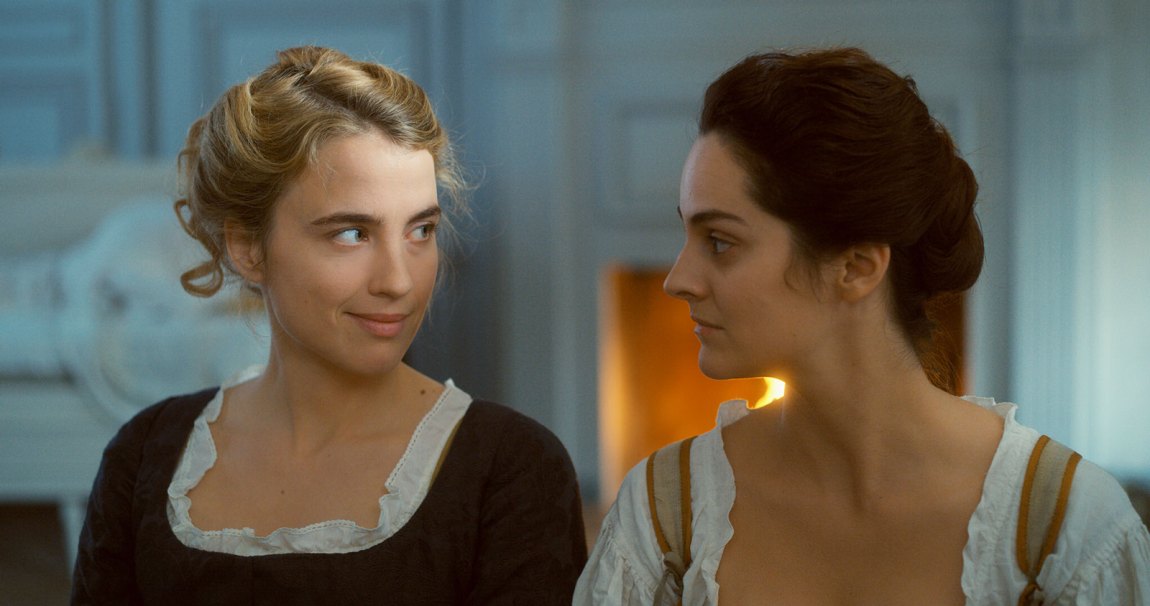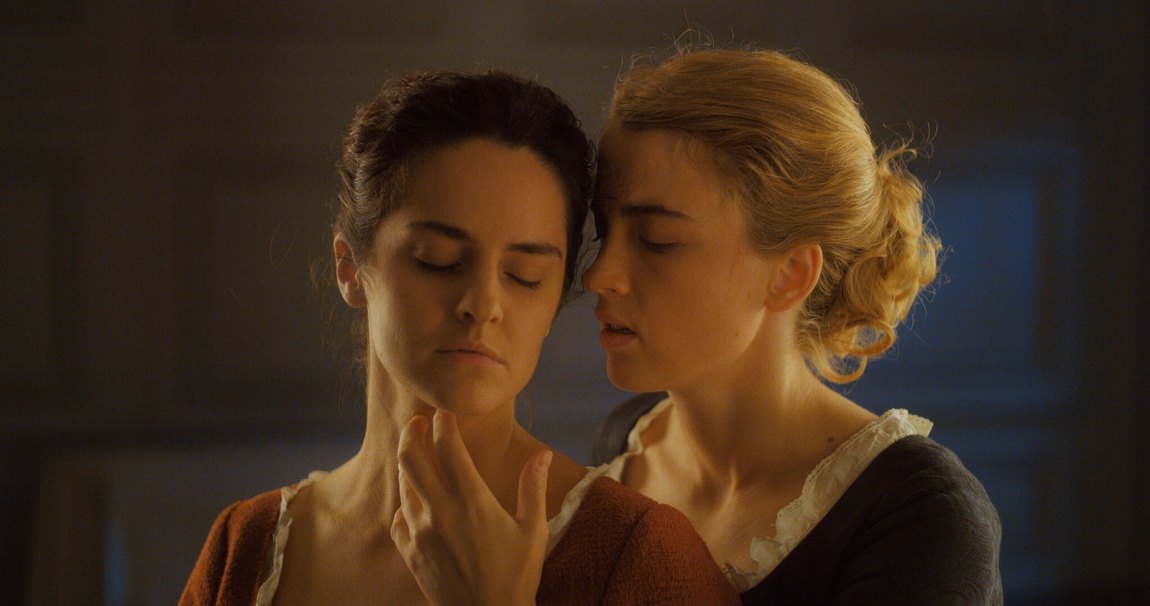At a table in a dark kitchen, Mary Anning’s dying mother (Gemma Jones) cracks a hardboiled egg and finds a chick. She rises and dumps the ruined little body in the sink without ceremony, while Mary (Kate Winslet) eats her meager soup in silence. Dropped by the sink are the tools of Mary’s trade, chipping hammers and chisels and vials of acetone; on a small shelf are the porcelain figurines that mark the children her mother has lost, a staggering but sadly ordinary eight, and just beyond them, a mirror, which catches, from time to time, Mary’s exhausted face. The arresting image of the dead chick, set in this diorama of a fossil hunter’s nineteenth-century kitchen, structures Francis Lee’s quiet and often wonderful film.
Ammonite is a story about motherhood, austerity, and sudden revelation. The landscapes are bleak and forbidding, the romance tender but not viable. Mary Anning was indeed a real woman, whose work on the “Jurassic Coast” of southern England yielded some of the most important paleontological finds of the nineteenth century; there is no evidence she was a lesbian (or not) but plenty to suggest she was flinty, daring, and furious, which is exactly how Winslet plays her. With admirable subtlety, Lee, who made his directorial debut in 2017 with God’s Own Country, charts a course for Mary and Charlotte Murchison (Saoirse Ronan), the frail wife of a boorish amateur geologist who has herself recently lost a child. To find love, they must cross not only social chasms but personal ones and ultimately choose which side they can bear to live on.
But most of what you hear in the press coverage of Ammonite has to do with sex: how Winslet described going down on Ronan as “definitely not like eating a sandwich,” and perhaps why the sex scene is the only really good part of the movie, or, in other tellings, another very bad part. For an actress to play a lesbian is, in the twenty-first century, no longer such a big deal. But what occurs in her love scenes—and with whom—apparently still is. The Ammonite buzz bears much in common with the excitement about a number of recent lesbian films, including Disobedience (2017) and Carol (2015), in which established female stars get it on with other, aspiring female stars, as if lesbian sex were a performance akin to the movie trope of the “ugly role,” in which gorgeous women gain weight and eschew makeup in order to play serial killers or recluses. (Already, there is Oscar talk for Winslet.) Most of the time, in fact, the sex in these films is not particularly interesting or groundbreaking. When Rachel Weisz spits precisely, almost angrily, into Rachel McAdams’s mouth in Disobedience, one is left only with the impression that something shocking has happened, without having been actually shocked.
In Ammonite, the sex—choreographed competently by Winslet—is as practical as Mary’s dull dresses, shed in the dark kitchen for a quick sponge bath. (There is much casual and inelegant undressing in the film, a visual motif that strengthens the themes of revelation and uncovering. Like the fossils embedded in rock, these characters must be prized from the sediment of their lives.) This practicality is unusual, perhaps, in a film with such radiant stars as Winslet and Ronan, of whom one might expect wild nights and showiness (see: spitting). But as Anthony Lane put it in The New Yorker, the remarkable thing about Ammonite is “the alarming clarity with which it addresses the elemental.” The sex is no different.
In the same kitchen of the boiled chick and the sponge bath, on the table where sandwiches are eaten, Mary hikes up Charlotte’s dress and buries her face under its folds. A wide pull-away frames both women’s bodies, fully clothed, and then a pull-in of Ronan’s face reveals the pain of desire; desire is both transportative and elsewhere. It is a wonderful scene, even if it is rather unsexy. It suggests that pretense is a luxury afforded only those without work, only those who would live later. An odd little fossil for the future to uncover.
But the second love scene, on the final night before Charlotte must return to the city and her monstrously polite husband, plays out in more conventional manner: a bit of kissing, an increase in desire, desire’s coup. This first sequence, focused on the women’s faces, is lovely and beautifully shot. But then, once desire has taken over, the camera betrays Mary and Charlotte. Pull-in shots carve up the women’s bodies into segments. Someone’s hand lifts someone else’s nightdress. A hill of thigh, mounds of breasts, and then one woman sliding down between the other’s legs, faces obscured, more disembodied parts, until finally Charlotte ascends to Mary’s upturned mouth very much as she might climb a Dorset cliff, in search of ancient patterns in rock. All through, the light is bright and unwavering; one imagines the cold plaster of Anning’s walls, where Charlotte rests her head. Then all is quickly over. The next day, Charlotte leaves for upper-class London and Mary’s mother dies. “As the land meets the ocean, so death meets desire,” Lane writes, and in each some little passion is expended.
Advertisement
Watching the scene, I was put in mind of Susan Sontag’s early lecture on the “pornographic imagination”: porn, she argues, is defined by a necessary distance, on the part of the reader or viewer, from the actors. The actors’ psychology is unimportant and unavailable; so, by implication, is sexual joy. People become things, the way a mollusk becomes a fossil, evoked but no longer present. (Importantly, Sontag is discussing a “modality…in the arts,” and not one of the other two pornographies she briefly describes, as a social or psychological phenomenon.) People, in a pornographic mode, “constitute a certain kind of landscape.” Siri Hustvedt, in her essay on Sontag, compares this to surrealism’s “programmatic search for estrangement.”
For anyone who has seen Ammonite, or just about any lesbian film, this description may feel disappointingly apt. If you are a connoisseur, as I am, you know that the wide pull-away shot, in which bodies are differentiated and subjects foregrounded, seems reserved for straight folks (think Normal People), who very often get to see their own full, universal choreography, focused on the penetrative act. It is almost impossible to find a lesbian sex scene in Western film without the entwinement of fingers, shot in close-up against the sheets; the gauzy jump cut is common, from one body part to another, cut off from the expressive vessel of the face, very much as if hips, necks, and thighs were geographic features, arranged to make a human landscape.
To read such scenes generously is to acknowledge the way in which they seek to pay a beatific homage to the feminine form. But such scenes are also amorphous, without tension, unreal. Certainly, they are vanilla and cloying, but there has always been, to me, something sinister about them, too. Of Blue Is the Warmest Color (2013) I have more to say below, but as Manohla Dargis points out in her long and embattled review of it: “both the pornographic and the sacred generally treat women as abstractions instead of flesh-and-blood individuals.”
What is also true—though not, one imagines, intentional—is the way such sexual foreclosure of the feminine body fragments the act of touch. It makes touches rather than does touching, which is another way of describing the pornographic. When Mary and Charlotte make love the second time, there is no wide shot, no pull away. The camera disembodies them. Consider the alternative: to regard women’s bodies fully may not eliminate the pornographic, but it does create a sexual story. It differentiates one woman from another. It makes sex between women narrative, and in that way can admit reaction, shifts in power, pauses, climaxes, rest.
And yet, all of this mediated and voyeuristic sexual contact is perhaps better than no sex at all. Lisa Cholodenko’s breakthrough movie The Kids Are All Right (2010) stands as the only other mainstream, big-budget American film of the last two decades or so, besides Carol, to center lesbian desire and relationships. (I have little to say about the very recent Happiest Season (2020), not only because Kristen Stewart has more chemistry with Dan Levy than any of her potential love interests, but also because it strives so openly for the ordinary. Still, it warrants a mention here, precisely because it is wholly without sexual energy.) But the story is about how women’s desire for one another is inflected, even defused, by the presence of men. The single sex scene between Nic and Jules is literally framed and mediated by gay male pornography, which is on the television in their bedroom; by contrast, Jules’s affair with Paul is forthrightly naturalistic and meant to demonstrate the perils of lesbian desire. Given these choices, it is understandable that a filmmaker might prefer the abstract, floating, nonnarrative sex so common to lesbian film. As Terry Castle suggested, in The Apparitional Lesbian, even in our contemporary moment it can be difficult for people to imagine women in bed together. Such a refusal to imagine and depict the sexual lives of lesbians “obscures the specificity, one might almost say melodrama, of lesbian desire.”
All of this is rather inauspicious for lesbian romance and surely evokes cinema’s general cynicism about it. (“It is no wonder,” Castle continues, “that lesbians…have engaged in a sort of self-ghosting, hiding or camouflaging their sexual desires.”) A film like The Kids Are All Right is really much more about white, bourgeois sensibility than it is about any experience particular to lesbianism, in spite of the set-up. As Roger Ebert put it, Cholodenko’s film “centers on a lesbian marriage, but is not about one.” Indeed.
Advertisement
But we’re talking about the mainstream cinema—what can one reasonably expect? Still: ask yourself how often in lesbian film the characters’ lovemaking is mediated by a window or mirror. In Ammonite, the small mirror in the kitchen casts Mary back to herself and plays a watchful role in each scene that occurs in that room. When her mother tries to remove the looking glass, Mary gently scolds her. At several points, Mary and Charlotte look carefully at each other through a window—of a carriage, a shop, a house—a motif that foreshadows the heartbreaking final scene. Windows and mirrors abound in lesbian film, from Desert Hearts (1985) to The Watermelon Woman (1996) to The Favourite (2018).
In Carol, the first kiss is framed by the mirror in which Carol (Cate Blanchett) and Therese (Rooney Mara) regard each other’s reflections. Therese, the younger, inexperienced lover, is seated in front of a hotel vanity. The older, richer, more sophisticated Carol stands behind her. They each watch the other and themselves, while, from farther back, the viewer watches them together. From this perspective, their waiting and their hesitation are sexy but also deeply voyeuristic—and voyeuristic from all angles and for all subjects. For forty-five minutes, Carol and Therese have been gazing at each other and just barely parting their lips, and their hair has been moving only slightly in the breeze. The kiss fails to unhinge them. After so much anticipation, the moment feels more like a finality than an opening door. After all, a climax is a kind of finality, which the romance of narrative has labored to make inevitable. We have seen their kiss coming for the best part of an hour, and now we see them see it in the mirror. It is for us.
And what is a mirror but a form of disembodiment? Jacques Lacan, from whom film scholars reinterpreted the notion of “suture,” famously described the mirror stage of psychological development first as a transformative moment in the life of a child, in which she recognizes the figure in a mirror as herself, and later as a paradigmatic phenomenon in which the human learns to recognize herself as an object, both in the mirror and in material form. The self can be seen from the outside, regarded, and finally desired. The reflexivity of the mirrored image creates a fantasy of the self, an ideal self, which the subject can view from afar. As Lacan put it, “The mirror stage is a drama…which manufactures for the subject, caught up in the lure of spatial identification, the succession of phantasies that extends from a fragmented body-image to a form of its totality.” In other words, where we might see a series of parts—eyes, hands, mouth, breasts, genitals—we instead make a whole we understand to be ourselves.
But a mirror is also a way we watch others watch us, just as Carol and Therese see both themselves and each other. In a mirror, I can see you seeing or not seeing me. So when I watch a lesbian movie, I am seeing myself and also the manner in which I am seen, in a kind of shot reverse shot of the self.
Some evenings, when the day has been long and I am lonely, I search the Internet for “lesbian movies” or “lesbian romance.” What do I find? So little, so much of the above. So why do I keep looking? Do I want the erotic jolt that comes from the vision of women touching one another, because its scarcity intensifies both anticipation and satisfaction? Or because, in the cinematic suturing of perspective, I am hoping to see myself make love and be made love to? I ask the straight people among you: When you were little, when your own sexuality was a strange and new and fluctuant animal, and you saw a man and a woman kissing or touching in the movies, did you feel that you were glimpsing a mystery? Is this what you are looking at when you watch a film? And when you look at pornography? Are those different questions?
*
In France, where the treatment of women in the cinema is generally more robust and varied than in the US, two recent films demonstrate how the visual language of lesbian sex can change almost everything about who watches a film and why. One is a masterpiece, and it bears much in common with Ammonite. Céline Sciamma’s Portrait of a Lady on Fire (2019), recently reviewed (along with The Favourite) in these pages by Elaine Blair, is set in Brittany in the eighteenth century. The premise is tight and ingenious: Marianne is an artist, commissioned to paint the portrait of Héloïse, which will be sent to Héloïse’s suitor to prove her beauty before marriage. Another painter (male) has attempted this and been thwarted by Héloïse, who refused to sit for him. Thus Marianne must gaze in secret upon Héloïse, mentally recording her likeness in order to paint her later. Marianne is therefore introduced by Héloïse’s mother as a walking partner, and for much of the film the two women wander along the cliffs and great blue swells of the coast, much like Mary and Charlotte, looking carefully at each other.
We know from the premise that this will be a film about the gaze directed at women, particularly by those who would make art of them. But by the time Héloïse discovers Marianne’s true purpose, they’ve formed a passionate connection. When Héloïse consents to sit for Marianne, it is because she believes in and supports Marianne’s artistic vision, even though its realization will end their romance. Being painted also gives her the opportunity to gaze back at Marianne.
In both Portrait and Ammonite, the protagonists must challenge the customs of desire. They do so through work. Specifically, women’s freedom to work and the way in which sexual passion, with its vocabulary of ownership, compromises that freedom. The conclusions of each film, following closely their respective final love scenes, tell us how to feel about that conflict, which is, in essence, a conflict of subjectivity.
Undoubtedly, Portrait is in part a direct response to another French film, directed by a man, about art and passion between women. Abdellatif Kechiche’s Blue Is the Warmest Color is perhaps the most widely seen lesbian film of the last thirty years, and one of the most controversial films on any subject in recent memory. A centerpiece is a seven-minute-long (it feels longer) explicit sex scene between Emma (Léa Seydoux), an aspiring artist, and Adèle (Adèle Exarchopoulos), her muse. The actors wore prosthetic genitals and later talked of the filming as “harrowing,” but for all that, the love scenes are not particularly sexy or realistic. (Not because, as many queer women objected, the positions are all wrong. They didn’t seem wrong to me, per se, except that there are so many of them.) It is rather that, separated from the light conceit of the film’s story, anyone would have a hard time differentiating the scene from pornography. In the end, it’s all rather clinical. The sex feels simulated, and I felt exhausted watching it.
There is a moment when Adèle and Emma are lounging, postcoitally—though the sex, for once, has not been shown, the women’s nakedness is nevertheless central to the tableau—and Emma, teasing Adèle, slaps her lover’s ass. The camera is trained on Emma’s face and the women’s torsos. The ass slap could be easily heard and inferred without moving the camera, a moment between lovers which requires no emphasis or explanation. Instead, the camera follows Emma’s hand and takes in the slap and the round perfection of Adèle’s ass. The point of view is undeniably the filmmaker’s. The camera’s panning to Adèle’s ass makes clear that we, as viewers, are meant to identify with a third and separate witnessing consciousness—the director’s, making ours complicit—and not with Emma, the lover. It forcefully reminds us that someone else’s gaze is present between the women. Something similar happens in Ammonite when Charlotte hauls herself to Mary’s mouth. The camera pans not up, to the pleasure in Charlotte’s eyes, but down, to the round peach of Charlotte’s buttocks, framed by Mary’s breasts. Both women’s faces are occluded. Whose perspective is this? It is neither Mary’s nor Charlotte’s. It is the camera’s and it is for us.
In Portrait, the big moment of recognition—of desire, of the other—occurs en regardant, at the moment Marianne understands that, as the painter, she is also seen by the subject. In one revelatory session, Héloïse calls Marianne from her easel to the platform where she, Héloïse, poses, for Marianne to stand in her own sitter’s sightline. “We’re in the same place,” Héloïse says. “If you look at me, who do I look at?” Later, when Héloïse tells Marianne that she has imagined her, Marianne asks if she means “dreamt.” Héloïse answers concisely: “No. I thought of you.” Nothing of the unconscious of dreams here, nothing of the apparition of fantasy. Two women stand regarding each other deliberately.
The central love scene occurs not in a long sequence of abstracted, midrange jump cuts but in a single shot of Héloïse’s fingers in Marianne’s armpit, the camera focused closely on this act of penetration. (They have acquired a hallucinogenic salve from town, which Marianne is applying. Sciamma said of this scene that she wanted to show unsimulated penetration on film, without crossing into pornography.) Unlike the love scenes in most lesbian romance, these moments of sex between Marianne and Héloïse have a moving, unforgettable precision. The armpit hair and the exploring digits (there is also spit, rightly deployed) are the punctum, the penetrating details that wound. The perspective is not the director’s, nor the viewer’s, nor either character’s. It is only the camera’s perspective; it reminds us that the camera is present. The extreme close-up of kissing lips, and then closer still to the penetrated armpit, remind us that watching is a responsibility, even a luxury, a paradox in which the subject might participate directly. Moreover, it reminds us, as Héloïse reminds Marianne, that the viewer might also be regarded.
All of this is rather different for gay men, which should not surprise us. The best thing about the sex in Call Me by Your Name (2017) is the famously fucked peach (an actual thing and not a person abstracted into one, metaphor though the peach may be). The peach also leads to the most explicit sex in the film—one might be tempted to say the only sex, since at the moment the two leads consummate their passion, the lens sheers away to consider a beautiful tree (we hear in sotto voce the continuation of their lovemaking, but we see the green, lush, waving leaves). After Elio has had his way with the peach, he dozes. Oliver enters the room. He sits on the edge of the bed while Elio lies prone across it. Both men are shirtless, and the light is sufficiently aureate and dusty and Italian. When Oliver dips to Elio, the camera pans back and frames both their bodies in their entirety, in that long lovemaking shot one almost never sees in cinematic treatments of lesbian sex.
Many American viewers will have seen Jack embrace Ennis in the meadow in Brokeback Mountain (2005), or Chiron and Kevin shot from behind on the beach in Moonlight (2016), two films in which queer desire is corrupted by the nihilism of masculinity. But unlike the endless jump cuts of implied vaginal penetration, cunnilingus, the sucking of women’s nipples, the fingering of their genitals, all of which are ubiquitous in film, most people will not have seen the similarly implied fellatio one man performs on another, framed in midrange, like a Renaissance marriage portrait. Elio’s cock tastes like a peach, Oliver notices with his male tongue, and then he discovers and eats the actual peach, filled with Elio’s ejaculate. Hot, gnarly, joyful.
More than knowledge, then, the fruit of sexual hunger is about joy. It’s about deliciousness. What both Ammonite and Portrait of a Lady on Fire want most is the interaction of subjects unmediated by outside gazes or outwardly directed performance, and unmediated by art-making’s—and lovemaking’s—possession of the subject. Only one succeeds. At its bitter finale, Mary stares impassively at Charlotte through the glass case containing her most famous find, one of the first intact ichthyosaur skeletons, and Charlotte stares longingly, pleadingly back. She hopes that Mary will leave forbidding Lyme Regis and come live with her in splendor, if also in secret. They are like two mannequins, or one person staring at her own reflection. They do not see each other.
In the false dilemma so common to Western love stories, Mary must choose between her true passion (in this case, work) and the comforts of love. In Portrait’s moving coda, Marianne watches Héloïse listen to the final, ecstatic summer section of Vivaldi’s Four Seasons, years after their affair, across a crowded concert hall in Milan. Héloïse does not know Marianne is watching and presumably never will; Héloïse’s joy is unperformed. All the wonder and pathos of the moment is about Héloïse’s enrapturement: her chest heaving and her face bewildered, she is helpless before beauty. This is what sex looks like when the subject is present.






